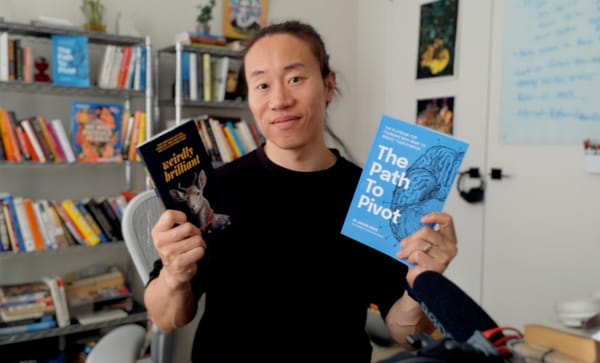A friend of mine, Phil Carter, a former VC & product lead turned growth advisor, has been debating whether to write a book. Having self-published both The Path to Pivot and weirdly brilliant this year, he was looking for advice on the pros & cons of writing a book as a small business owner.
I figured some of you might be curious about that same question, so here's a cleaned up version of the advice I gave him.
Hard But (Spiritually) Rewarding Work
A lot of people have told him that he needs to write a book about all his research and expertise around consumer subscription apps, especially around his Subscription Value Loop (recently published in Lenny's Newsletter). On the other side, many people have told him not to write a book because it's a lot of work, takes way longer than you think, and doesn't make a lot of money.
I see writing books as a long-term investment in your expertise and your authority. It's a differentiator for sure—books demonstrate credibility, can be passed around or recommended to others as a taste of your approach, and can lead to press or media opportunities.
But as many have said—don't write books for the money. They may not lead to immediate results in terms of book sales, new leads or even higher conversion in the short term.
I found writing and publishing my books to be of immense personal satisfaction—like training for and running a marathon, doing a major home renovation, or taking a big trip around the world. It's not necessarily about just the business outcome.
Creating something that is authoritative and valuable that expresses your point of view is an inherently meaningful, especially for someone who is committed to talking about this topic and being associated with this topic for a long time.
Books make great gifts: I have given away at least 30 copies of both my books and people love receiving a well-designed book (signed by the author!) Regardless of if they do more than page through it, I can tell I've gained more of their respect and appreciation.
Learn How to Write a Useful Book
Assuming you're looking to write a book that is practical and directly helpful to the reader, I would highly recommend reading Write Useful Books by Rob Fitzpatrick. Rob has the credibility of having self-published both very popular book on customer validation, The Mom Test, and a very useful about workshops. I also participated in Rob's Useful Author's community and his cohort course based on the book so you can see my book in their catalog.
Write for the Backlist
The backlist are the books that sell perennially—think 48 Laws of Power or When Things Fall Apart or Never Split the Difference—writing for something that will be shared by word of mouth and will become more and more valuable over time. For instance, The Mom Test has sold 500,000 copies over a 10-year period, despite having no big "launch" in year one—while still growing sales year after year.
That means you have to write about something that is more timeless than timely. Don't write a book about optimizing Tiktok marketing—that will not hold up in 10 years. But a book about how to tell stories with video, or even how to evolve from horizontal to vertical video, or helping married couples stay connected after they have kids, or how to land and negotiate job offers as a woman, those are book topics that will stay relevant and valuable 5, 10, 20 years from now with maybe some minor modifications.
Write to Solve an Identifiable Problem for a Particular Audience
Rob talks about being very specific about who this book is for and what problem it solves. Similar to building a V1 product. This is kind of obvious in retrospect, but as someone who has trouble narrowing down my work, it was enlightening.
I made it extremely clear in The Path to Pivot that this is a book for venture-backed startup founders a few of years into their business wanting to make a big change. Anyone else (bootstrapped founders, investors, big tech PMs etc) can still feel free to read it, but they're not allowed to get mad that I didn't cover some situation or scenario that they deal with because I didn't write it for them and it's very clear and upfront. That helps make sure that the word-of-mouth referral loop is tight.
Ideally the problem is also one that is easily identifiable. If you find out a guy is expecting his first kid, it's easy to recommend The New Father or offer Breakup Bootcamp to a recently single friend—it's right there in the name. But hidden problems are harder to target.
That second part is a problem for me with Path to Pivot, as founders are often a bit more quiet when it comes to somebody who is in the middle of a pivot is not actually that easy. It's a lot easier to find people who are new fathers or planning to be new fathers or getting ready to start a company or trying to grow the sales of their product. Thinking about and actually making a pivot to your business when you already have one thing and then you want to go do something else isn't actually that easy. It's a very specific window, so that's a challenge for me, but definitely something to think about.
Making the Book Worth the 3 Costs
According to Rob, to write a book that spreads via word of mouth, you need the book to overcome the three costs to a reader:
- The cost to buy the book ($10-25)
- The cost to read it (2-6 hours)
- The cost to implement the advice (a few hours to a few months or more)
The referral loop works only if a reader can get through all parts of the process. Even giving a book away for free isn't good enough if they don't read it. And if they read it but find the advice too hard to implement, they still won't recommend it.
But if you can get them to cover all 3 costs AND have a successful result that really changes their life, they will recommend the book to other people. Those recommendations, both in person and on review sites like Amazon, will drive the kind of buyers and readers that you want.
Beta Reading
In order to do that, you need to make sure the book actually meets people where they are. Rob recommends this process called beta reading where he has people read the book and give you feedback along the way, almost thinking about a retention graph for some kind of software product, making sure that people can make it through all the chapters.
This requires you getting beta readers, which means that you need to be in touch with your audience. If you can't reach your audience, then maybe this isn't a book that you should be writing in the first place. He has a tool called Help This Book that allows you to share it with people. They can leave feedback. You can kind of collate and summarize the feedback. It allows you to visualize it more easily.
How Long Does it Take?
Obviously it depends on your topic and how comfortable you are with writing and publishing.
For The Path to Pivot, the timeline could be considered 6 months or 2 years, depending on when you start counting. August 2022 I did Ship 30 and wrote 30 Twitter threads about pivots, then published a series of articles on Medium. I then took about 6 months off and started up again in August 2023, write 5000 words of a business fable that was meant to convey the lessons of Path to Pivot before finally writing the outline that would turn into the book.
That's the 6 months that actually took me from October 2023 to April 2024—putting the pen to paper, organizing, writing the initial draft, making changes based on beta reader feedback, doing second iterations to test that the new changes were effective, and actually creating a cover and packaging the book so that it could be sold in print and on Amazon. It clocked in around 40,000 words and ~200 pages.
I mostly relied on third party reporting or first party recollection from my own pivots. Along the way I interviewed maybe 3-4 founders who had pivoted. If I had done more, I think it would have taken much longer.
For weirdly brilliant, it took a bit over 30 days from first pages to published form. This one was straight off the dome—no footnotes or citations—and my goal was to publish whatever I had at the end of the month long sprint so it ended up much shorter (11,000 words, 150 pages including lots of visuals)
Staying Motivated
This is probably the hardest part for me and why most of my previous attempts at writing a book to date have been stymied or half-baked. I don't proclaim to have any magic bullets here but for what it's worth:
- Pick a topic you already know well but also have interest in going deeper
- Know why you are doing this and ideally it's more the intrinsic reward than external ones
- Be clear what is in scope for the book (who it is for, what it needs to cover) so you don't get overwhelmed in the research process
- Try to work on the book every day if you can
- Remember that a finished imperfect book is worth a lot more than a perfectly unfinished one
- Write with friends, join writing groups, work with an editor (I recommend Rachel Jepsen!), get people who want to read your writing
Resources for Self-Publishing
- Vellum ($249)—downloadable software for Mac that makes it easy to format books for print and ebook publication, so you can sell not just on Amazon but Apple's iBooks, generate nice PDFs, etc.
- KDP (freeish)—the software that Amazon provides to upload your book to publication on print or digital is actually pretty good all things considered.
- Canva (free/premium)—I designed weirdly brilliant all in Canva and they have some great tools for covers and book mockup imagery
Hybrid Publishers
If you want help with your book but don't want to do a full traditional publisher (something I'd like to do in the future but haven't done yet), you can look at hybrid publishers—they move faster and often help with a round of edits, cover / formatting content, bookstore distribution if you want that, and sometimes launch / marketing support.

